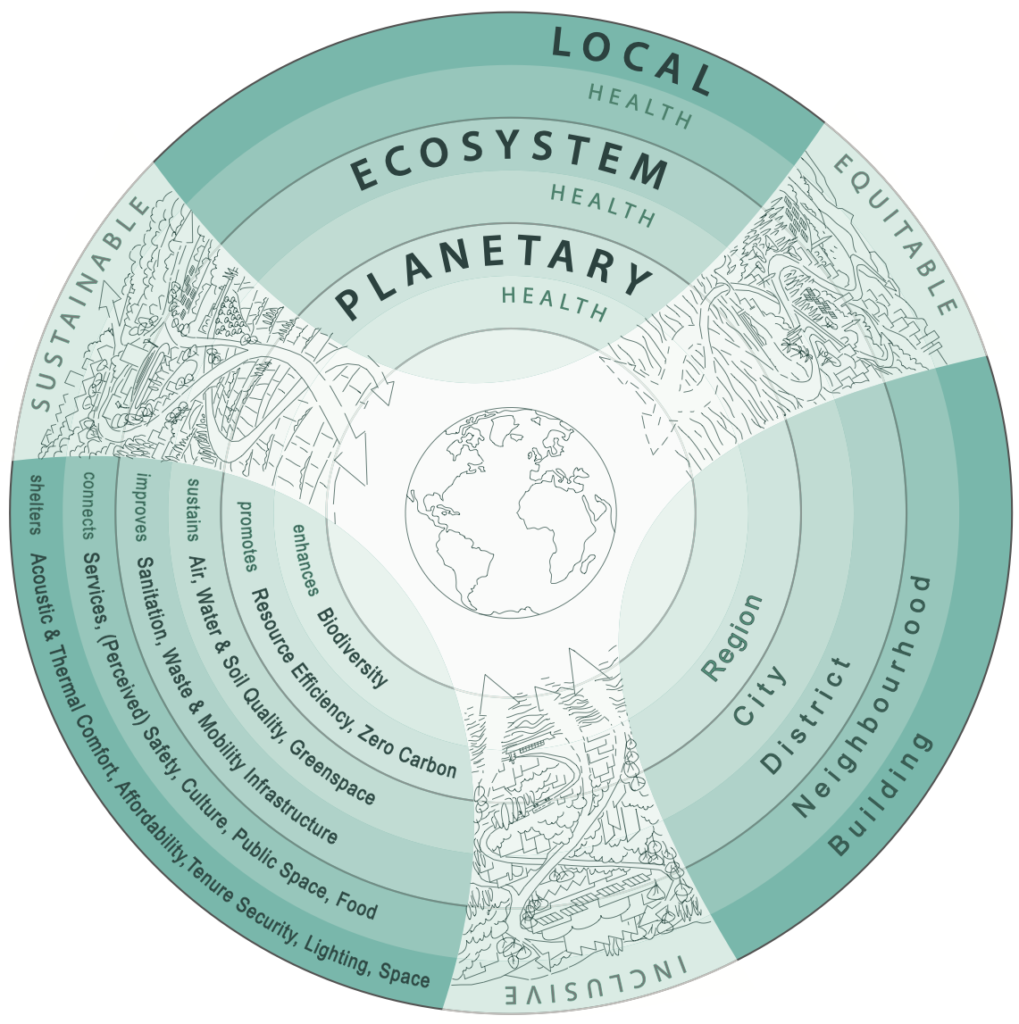Key messages of THRIVES
The THRIVES Framework aims to communicate these key messages:
- Health impacts often occur far away from new development or many years after construction. We need to consider health impacts beyond property boundaries.
- Structural barriers to health are partly caused by urban design processes and outcomes that exclude groups in society, including: low income, children, women, disabled, elderly and ethnic minorities. Proposed changes to improve health should include universal and targeted solutions. Affected communities should be involved in shaping solutions.
- Environmental degradation caused by cities is an urgent public health issue that must be addressed in urban development. Sustainable design and planning strategies should be adopted to promote health.
What does the image mean?
THRIVES uses words and images to evoke processes and outcomes of healthy urbanism.
The centre of the THRIVES image is an illustration of landscapes that connect global to local environments with three core principles that define a healthy place: inclusive, equitable and sustainable. Moving these considerations to the centre of the diagram purposely reorients our thinking towards structural factors that affect health. This is in contrast with traditional models that start with individuals, their genes and ‘lifestyle choices’. In fact, we now recognise that choices about where and how to live are heavily constrained by societal and environmental factors, many of which are determined by the built environment.
Three core principles:
Inclusive: Enables all members of society to conveniently participate in daily activities without feeling that they are disadvantaged by their personal characteristics or needs, and this is achieved through participatory processes. Inclusive urban environments represent both an outcome to strive for and a process to follow.
Equitable: Gives access to health-promoting environments to all residents and specifically considers and seeks to reduce barriers to access (be they physical, cultural, social or economic).
Sustainable: Supports the needs of the current (and immediately local) population without compromising the needs of future (or spatially distant) populations. Multiple interpretations of sustainability co-exist.
The rings show three interconnected scales of health impact: planetary health, ecosystem health and local health. The scales of health impact are pathways through which urban environments affect human health and they are aligned to a set of example design and planning goals. In turn, these link to scales of urban decision-making related to the built environment.
Three scales of health impact:
Planetary health refers to ‘the health of human civilisation and the state of the natural systems on which it depends’.(1) The built environment causes environmental degradation at a global scale through resource-intensive design, construction and operation and through habitat destruction that reduces biodiversity. THRIVES shows three example pathways through which the built environment can support planetary health: enhancing biodiversity and promoting resource efficiency and zero carbon systems.
Ecosystem health references an ecosystem services perspective whereby ecosystems provide food, clean water, climate regulation and recreational opportunities, and in turn these services support human health and wellbeing. Ecosystems are ‘webs of connections between living and non-living system components’ and they are foundational to human health (2). THRIVES lists five example goals for ecosystem health: sustaining air, water and soil quality, and greenspace, and improving sanitation, waste, and mobility infrastructure.
Local health contains two rings in the THRIVES Framework representing design and planning decisions for buildings and neighbourhoods. At the neighbourhood scale, example design and planning goals are to connect people with services (covering employment, education, retail, leisure, healthcare and other facilities), perceived and actual safety, culture, public space and food. At the building scale, example goals are to shelter people with acoustic and thermal comfort, affordability, tenure security, lighting and space.

What is different about THRIVES?
THRIVES puts core principles and planetary health at the core of a healthy urbanism model. Moving these considerations to the centre of the diagram purposely reorients our thinking towards structural factors that affect health. This is in contrast with traditional models that start with individuals, their genes and ‘lifestyle choices’. We now recognise that choices about where and how to live are heavily constrained by societal and environmental factors, many of which are determined by the built environment.
How can THRIVES be used?
- Build shared understanding: THRIVES provides a structure for understanding healthy urban environments. The framework can support interdisciplinary collaboration and build shared understanding among practitioners working on design, policy development or impact assessment.
- Explore health impact: The Framework can be used to map the health impacts of places, policies or proposals (see case studies for examples). These activities may reveal gaps, but they may also show existing strengths/assets that could be built upon. The goal is to broaden existing understanding of health to integrate sustainability, equity and inclusion.
- Discuss local needs and priorities: Achieving an inclusive environment is both an outcome and a process. THRIVES can inform activities related to gathering community knowledge about health and place.
Who is using THRIVES?
People have started using THRIVES to explain healthy urbanism, guide development proposals, structure discussions about health impact and in teaching. Here are a few examples:
- UN Habitat’s World Cities Report 2022: Envisaging the Future of Cities (pp. 235-237)
- Salus and Dorsay’s, Guiding Principles for Planning Healthy Communities (pp. 18-23)
- Gemma Moore’s Using the THRIVES framework in postgraduate teaching to conceptualise healthy places (with student contributions)
Further information and references
The Healthy Urbanism book is structured using the THRIVES framework, providing evidence-based design and policy strategies and case studies to bring to life the conceptual framing. THRIVES was developed through research and participatory testing. The research is published in Cities & Health journal.
(1) Whitmee, S., et al. (2015) Safeguarding human health in the Anthropocene epoch: report of The Rockefeller Foundation–Lancet Commission on planetary health. The Lancet. 386 (10007), pp. 1973–2028.
(2) Buse, C.G., et al.. (2018) Public health guide to field developments linking ecosystems, environments and health in the Anthropocene. Journal of Epidemiology and Community Health. 72 (5), pp. 420–425.
